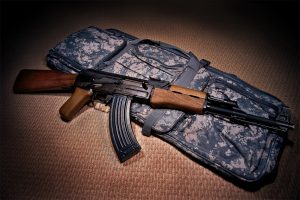By Jacob Parakilas

Toward the end of the Second World War, the German Army introduced a new type of infantry weapon: the StG 44, a select-fire, intermediate-caliber assault rifle firing from a 30-round detachable box magazine.
It represented a revolutionary concept. At the time, infantry soldiers carried a variety of weapons that were specialized for different tasks. Standard-issue battle rifles were lethal to distances of a mile or more but were bulky and clumsy in close quarters combat. Lower-caliber submachine guns and carbines provided high volumes of fire at short distances but were poorly suited for fights in open terrain. An infantry squad carrying a mixture of weapons would be able to fight in any scenario, but wouldn’t be able to share ammunition and would have some members poorly equipped for any given firefight. The assault rifle was designed to be a “good enough” solution in any scenario: capable of functioning well enough in both ranged and close-quarters combat that it could be issued almost universally, simplifying training and logistics in the process.
Three quarters of a century later, the German Army announced the winner of its new service rifle competition: the Haenel MK556, a select-fire, intermediate-caliber assault rifle firing from a 30-round detachable box magazine.
A modern assault rifle, of course, is much more reliable, accurate and adaptable than its World War II-era predecessor. But in the same period, other types of military equipment have undergone far more radical change. Piston-engine fighters have been replaced with supersonic, radar-evading jets armed with precision-guided standoff weapons. Heavily armored warships bristling with guns have been supplanted by lighter, stealthier ones designed to fight with missiles and embarked aircraft. By that standard, are we overdue for a revolution in small arms, and if so, what would it be?
Given the shape of technological advance in the last 75 years, the obvious area of evolution for individual weaponry would be computerization. And certainly, there have been some instances where this has been deployed successfully — thermal and night-vision scopes, for examples. But more exotic applications have largely floundered. The US Army’s XM25, for example, was supposed to be a hybrid rifle/grenade launcher capable of firing shells that would airburst at a precise distance, for example to kill enemy combatants hiding behind cover. But it was abandoned when it proved excessively heavy, expensive, and impractical in real world conditions.
Similarly, a few years ago a company called TrackingPoint introduced a precision rifle with a computerized scope which would essentially calculate long-distance shots for the shooter and fire once the weapon’s barrel was aligned with the calculated target. The premise was that it could instantly transform a novice into a marksman; the original use case was for wealthy big-game hunters (as demonstrated by its inclusion of a mechanism for recording and sharing clips), but there were clear military implications. But the technology proved unreliable and potentially vulnerable to hacking.
This is a fundamental problem when it comes to the idea of an electronic rifle firing silver bullets. The AK-47 and its offshoots and variants did not conquer the world by being the most-accurate, fastest-firing or hardest hitting weapon on the battlefield; they did so by being simple to manufacture, legendarily robust, and fairly easy to operate. A weapon that performs 50 percent better under test conditions but which is 25 percent more likely to malfunction in the field will be preferred by roughly 0 percent of combatants. Until electronic aids are proven to be as reliable as the weapons they’re attached to, they will remain rarities rather than widely deployed game-changers.
What might change significantly is how small arms and their components are manufactured.
To be clear, there is a huge amount of hype around novel manufacturing techniques, especially 3D printing. At this point in their development, 3D printers either work in soft materials that are not suited for firearms manufacturing; or are so large and complex they offer only marginal improvements on existing manufacturing techniques. But the technology is progressing rapidly. It is not hard to imagine 3D printers being forward deployed to relatively small units empowered to experiment and accessorize their weapons to compensate for local conditions. A unit fighting in hilly, rural terrain might choose to print larger-caliber receivers and longer barrels to give them an edge in long-range fights, while another deployed to a city might instead print larger-capacity magazines to help in frenetic, close-quarters fights.
That system, however, would represent a more fundamental challenge to military order and logic. Soldiers in the field have always modified their equipment; sometimes the modifications are retrofitted onto equipment at the factory level. But industrialized militaries have logistical systems that match their command structures: centralized and hierarchical. Passing the ability to design, produce and field test equipment to the troops in the field would truly represent a sea change, even if what they produce turns out to be yet another variant of a type of gun first fielded before their grandparents were born.
No comments:
Post a Comment